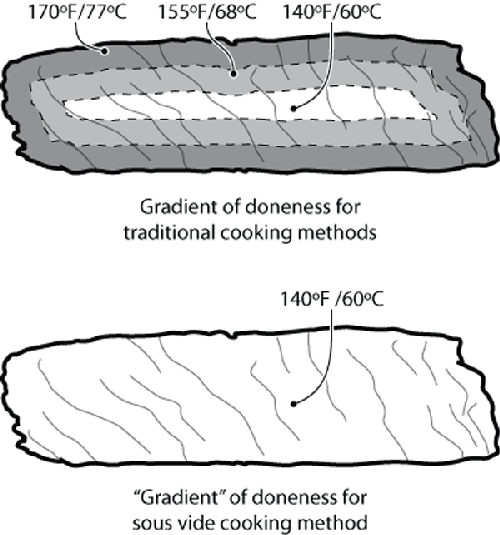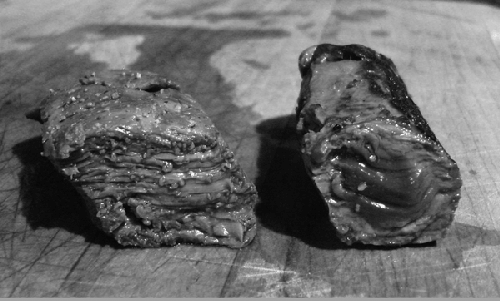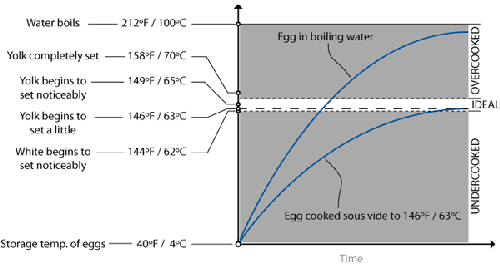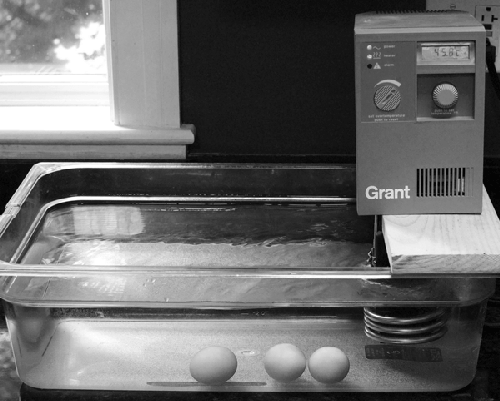With a name like “sous vide,” this cooking technique
sounds foreign, and for good reason: the French chef George Pralus introduced it to the
culinary world in the 1970s. While foreign in origin, it is certainly not complicated or
mysterious. At its simplest, sous vide cooking is about immersing a food item into a
precisely temperature-controlled water bath, where the temperature is the same as the target
temperature of the food being cooked. Translation? Ultra-low-temperature poaching. And since
the temperature of the water bath isn’t hotter than the final target temperature, the food
can’t overcook. Sous vide cooking essentially locks the variable of temperature in the “time
* temperature” formula.The temperature of the water bath is chosen to trigger chemical reactions (e.g.,
denaturing, hydrolysis) in some compounds in the food while leaving other compounds in their
native state. It is one of the biggest culinary revolutions to hit the commercial cooking
scene in the past few decades, but has appeared in the U.S. only recently. If I could pick
only one new cooking method out of this entire book for you to try, sous vide would be it,
hands down. The reason sous vide is so, well, amazing is that foods cooked this way have no
gradient of doneness and the associated overcooked outer portion. Instead, the entire piece
of food has a uniform temperature and uniform doneness.
Foods cooked sous vide have no temperature gradient, meaning that the
entire portion of food is cooked to a consistent level of doneness.

The name sous vide (meaning “under vacuum”) refers to the step in the cooking process
where foods are placed in a vacuum-pack plastic bag and sealed. Using a vacuum bag—a plastic
bag that is sealed after all the air in it has been removed—allows the water in the bath to
transfer heat into the food while preventing the water from coming into direct contact with
it. This means the water does not chemically interact with the food: the flavors of the food
remain stronger, because the water is unable to dissolve and carry away any compounds in the
food. (Sous vide is a funny name; I think it should have been called “water bath cooking,”
because the actual heat source is usually a bath of water. Bain-marie was already taken, I
suppose. Still, as with the name “molecular gastronomy,” once something gets popularized, it
tends to stick.)
The steak tip on the left was cooked sous vide at 140°F / 60°C; the one on
the right was pan-seared. Note that the sous vide steak has no “bull’s eye” shape—that
is, it’s consistently medium-rare, center to edge, while the seared steak is well-done
on the outside and rare in the middle.

Sous vide cooking doesn’t have to be done with a sealed bag in water. A few items don’t
need to be packed at all. Eggs, for example, are already sealed (ignoring the microscopic
pores), and when using this technique for secondary applications like preheating vegetables
such as bok choy for steaming, there’s no benefit to sealing the food in plastic.
You can also use other fluids
instead of water: oil, for example, or even melted butter. And because meats don’t absorb
fat the same way that they can water, when using one of these as the liquid medium some
applications can skip sealing. This can be extremely useful for those foods that might be
difficult to seal. Chef Thomas Keller, for example, has a recipe for poaching lobster tails
in a bath of butter and water (beurre monte, melted butter with water
whisked in, which has a higher burning temperature than butter alone).
Temperature-controlled air would technically work as well, but the rate of heat transfer
is much, much slower than for water—roughly 23 times slower. Given the low temperatures
involved, something like chicken in a 140°F / 60°C “air bath” would take so long to come up
to temperature that bacterial growth would be a serious concern. Using a liquid such as
water ensures that heat can penetrate the food via conduction—liquid touching plastic
touching food—rather quickly. Water is cheap and easy to use, so you’ll almost always see it
called for, but some chefs do occasionally use other liquids.
The classic example given to explain how sous vide cooking works is cooking an egg.
Since different egg proteins denature and coagulate at slightly different temperatures (most
are in the range of 144–158°F / 62–70°C), holding an egg at various temperatures within that
range will result in varying consistency of egg white and yolk.
To some, a “perfect” soft-cooked egg should have a slightly runny,
custard-like yolk and a mostly set white. Cooking an egg in water brought to a boil
can result in an overcooked end result, because the temperature of the egg ramps up to
boiling point until it is pulled out. In sous vide, the temperature of the egg reaches
only the ideal temperature of the cooked egg, so it cannot overcook.

By immersing the egg in a water
bath held at that temperature you ensure that the egg cannot get any hotter, so in theory,
those proteins that set at a higher temperature will remain in their native form. In
reality, most chemical reactions in cooking aren’t specific to a particular temperature, but
are dependent on time-at-temperature. In practice, though, this simple model is accurate
enough to explain how sous vide cooking works.
For a “perfect” soft-cooked egg, try cooking it sous vide at 146°F / 63°C for one hour.
Because eggs contain many proteins that set at slightly different temperatures, you can
experiment by adjusting the temperature up or down a few degrees to suit your personal
preferences.
Cooking eggs in a sous vide bath at 144.5°F / 62.5°C.

For other foods, consider the compounds they contain, determine the temperatures at
which the compounds undergo their different transformations, and pick a temperature high
enough to trigger the reactions you do want, yet low enough not to trigger the ones you
don’t.
Note:
Tip: after cooking an egg sous vide, crack open and drop the egg (without shell!) into
a pot of just-boiled water. Then fetch the egg out immediately. The hot water will
rapid-set the outside of the egg for better appearance and easier handling.
Sous vide cooking isn’t a magic bullet, though. For one thing, the textures of some
foods break down when held at temperature for any extended period of time. Some types of
fish will break down due to enzymatic reactions that normally occur at such a slow rate that
they are not noticeable in traditional cooking methods. Sous vide also doesn’t reach the
temperatures at which Maillard reactions or caramelization occur; meats cooked sous vide are
commonly pan seared or even blowtorched briefly after cooking to introduce the flavors
brought about by these browning reactions. The largest drawback, however, is the requirement
to pay serious attention to food safety issues and pasteurization.
Note:
Pasteurization reduces bacterial levels to a point where food can
be considered reasonably safe. If it is stored improperly after pasteurization, bacteria
can reproduce above safe levels.
Sterilization completely eliminates the target bacteria.